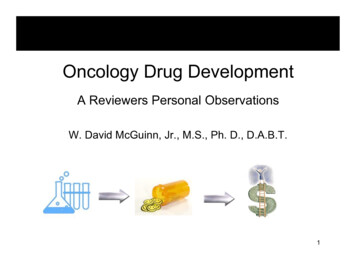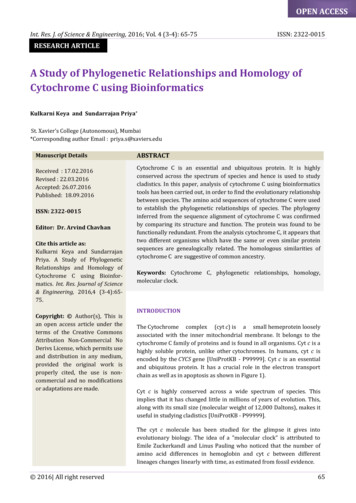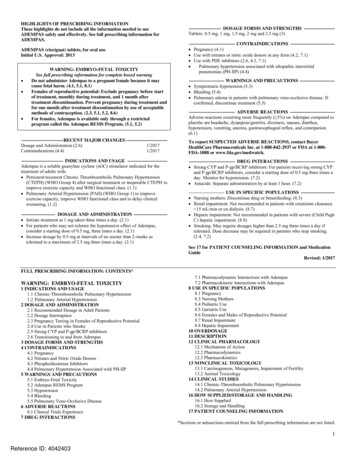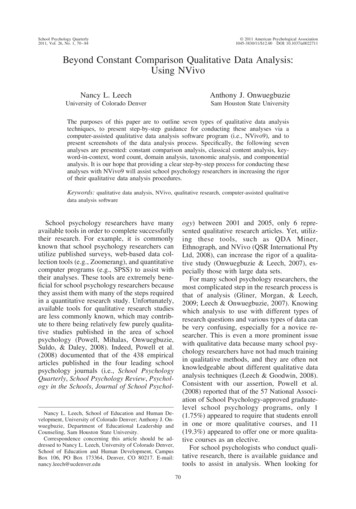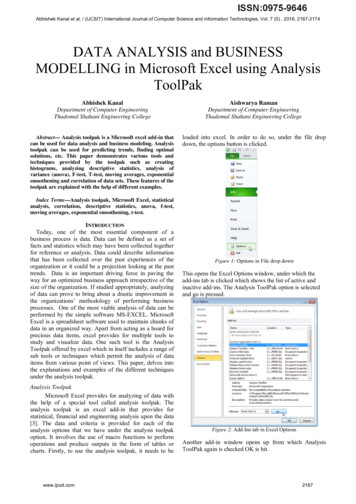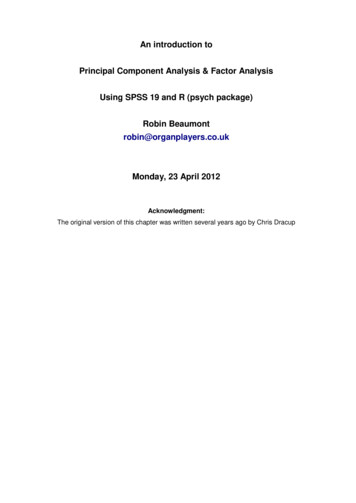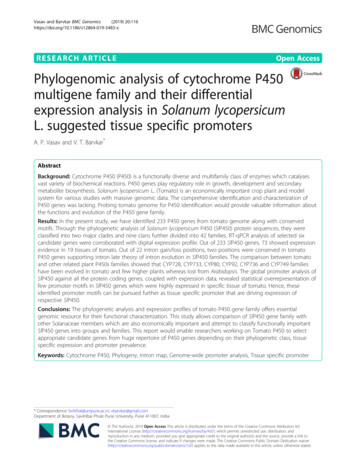
Transcription
Vasav and Barvkar BMC Genomics(2019) EARCH ARTICLEOpen AccessPhylogenomic analysis of cytochrome P450multigene family and their differentialexpression analysis in Solanum lycopersicumL. suggested tissue specific promotersA. P. Vasav and V. T. Barvkar*AbstractBackground: Cytochrome P450 (P450) is a functionally diverse and multifamily class of enzymes which catalysesvast variety of biochemical reactions. P450 genes play regulatory role in growth, development and secondarymetabolite biosynthesis. Solanum lycopersicum L. (Tomato) is an economically important crop plant and modelsystem for various studies with massive genomic data. The comprehensive identification and characterization ofP450 genes was lacking. Probing tomato genome for P450 identification would provide valuable information aboutthe functions and evolution of the P450 gene family.Results: In the present study, we have identified 233 P450 genes from tomato genome along with conservedmotifs. Through the phylogenetic analysis of Solanum lycopersicum P450 (SlP450) protein sequences, they wereclassified into two major clades and nine clans further divided into 42 families. RT-qPCR analysis of selected sixcandidate genes were corroborated with digital expression profile. Out of 233 SlP450 genes, 73 showed expressionevidence in 19 tissues of tomato. Out of 22 intron gain/loss positions, two positions were conserved in tomatoP450 genes supporting intron late theory of intron evolution in SlP450 families. The comparison between tomatoand other related plant P450s families showed that CYP728, CYP733, CYP80, CYP92, CYP736 and CYP749 familieshave been evolved in tomato and few higher plants whereas lost from Arabidopsis. The global promoter analysis ofSlP450 against all the protein coding genes, coupled with expression data, revealed statistical overrepresentation offew promoter motifs in SlP450 genes which were highly expressed in specific tissue of tomato. Hence, theseidentified promoter motifs can be pursued further as tissue specific promoter that are driving expression ofrespective SlP450.Conclusions: The phylogenetic analysis and expression profiles of tomato P450 gene family offers essentialgenomic resource for their functional characterization. This study allows comparison of SlP450 gene family withother Solanaceae members which are also economically important and attempt to classify functionally importantSlP450 genes into groups and families. This report would enable researchers working on Tomato P450 to selectappropriate candidate genes from huge repertoire of P450 genes depending on their phylogenetic class, tissuespecific expression and promoter prevalence.Keywords: Cytochrome P450, Phylogeny, Intron map, Genome-wide promoter analysis, Tissue specific promoter* Correspondence: bvitthal@unipune.ac.in; vbarvkar@gmail.comDepartment of Botany, Savitribai Phule Pune University, Pune 411007, India The Author(s). 2019 Open Access This article is distributed under the terms of the Creative Commons Attribution 4.0International License (http://creativecommons.org/licenses/by/4.0/), which permits unrestricted use, distribution, andreproduction in any medium, provided you give appropriate credit to the original author(s) and the source, provide a link tothe Creative Commons license, and indicate if changes were made. The Creative Commons Public Domain Dedication o/1.0/) applies to the data made available in this article, unless otherwise stated.
Vasav and Barvkar BMC Genomics(2019) 20:116BackgroundCytochrome P450 (P450) belongs to a very divergentmultigene family present in all living organisms. In angiosperms, approximately 300 genes are speculated pergenome in 50 plant families [1]. The P450 monooxygenases are heme-thiolate enzymes, which catalyse broadrange of chemical reactions like epoxidation, sulfoxidation, dehalogenation, dealkylation, C-C cleavage, ring extension, and reduction with the help of oxygen andNADPH [2]. They are involved in the oxidative metabolism of various endogenous and exogenous compoundslike herbicides, pesticides and xenobiotics [3, 4]. TheP450 proteins, present in plants are membrane boundand difficult to characterize [5]. The molecular mass ofP450 from plant origin ranges from 45 to 62 kDa withan average molecular mass of 55 kDa. They possess fourconserved key domains namely heme binding domain,I-helix, K-helix and PERF/W domain [6]. Heme-bindingsignature motif has 10 conserved residues among whichcysteine is highly conserved. This heme-iron motif has abinding site for oxygen and various compounds involvedin drug metabolism [7]. The P450 gene family is thirdlargest gene family present in Arabidopsis. Most of theP450 studied in plants are localized in the endoplasmicreticulum, chloroplast or mitochondria and other secretary pathways [8]. They are involved in many biosynthetic pathways such as alkaloids, flavonoids, lignans,isoprenoids, phenolics, antioxidants and phenylpropanoid [8–10]. The P450 genes are crucial in metabolismand tolerance to allelochemicals in plants as well as inanimals [11]. The gene families CYP90, CYP724 andCYP734 are involved in biosynthesis of steroidal saponins and glycoalkaloids. Different types of glycoalkaloidspresent in all members of Solanaceae family are vitalcompounds but toxic to other living organisms [12]. TheP450 proteins are involved in the biosynthesis of aglycones from cholesterol by oxygenation, transaminationand cyclization at different carbon positions. The P450mediated derivatization of glycoalkaloids made them lesstoxic and during course of domestication solanaceaemembers with less amount of toxic glycoalkaloids havebeen selected [13].Availability of whole genome sequences of large number of plant species allowed the genome wide identification of P450 multigene family in different plant species,namely soybean (Glycin max) [14], mulberry (Morusnotabilis) [15], flax (Linum usitatissimum) [16] and tobacco (Nicotiana tabacum) [17]. The draft genome sequence of tomato (Solanum lycopersicum) was madepublicly available in 2012 which provides an opportunityfor genome-wide study of tomato specific gene families[18]. Tomato (Solanum lycopersicum L.) is an economically important crop and routinely used model plant forfruit ripening, plant-pathogen interaction and molecularPage 2 of 13genetics mapping [19]. However, very few P450 geneshave been reported and functionally annotated from Tomato. Moreover, no comprehensive genome-wide studyof these genes has been reported until date. Therefore.in this study, we attempt to classify functionally important P450 genes into groups and families according tostandard P450 nomenclature committee [20, 21]. Understanding the molecular evolution, differential expressionin different tissue types as well as intron and promoteranalysis of SlP450 genes will pave the way for functionalcharacterization of important candidate genes.MethodsIdentification of P450 genes from the tomato genomeThe Arabidopsis thaliana P450 genes were downloadedfrom ‘The Cytochrome P450 homepage’ reported by D. R.Nelson ]. These 254 Arabidopsis P450 sequences were treatedas a query to perform BlastP search with the E-value 1e 40against tomato (Solanum lycopersicum) genome(ITAG2.3) available at Phytozome database V10(www.phytozome.net) [18]. Furthermore, a manual analysis of putative Solanum lycopersicum P450 (SlP450) sequences was conducted for the complete ORF andtruncation. The analysis consist of non-redundant andfull-length SlP450 genes. Universal names for SlP450genes were assigned according to the standard systemof P450 nomenclature committee [20, 21].Multiple sequence alignment, phylogenetic treeconstruction and conserved motif analysisThe 48 P450 protein sequences from other plants suchas Arabidopsis thaliana (40), Populas trichocarpa (1)and Solanum tuberosum (7) along with 233 SlP450sfrom Solanum lycopersicum were considered to construct the phylogenetic tree. The accession numbers areprovided in Additional file 1. Multiple sequence alignment of these P450 genes was carried out with Musclealgorithm [22] using default parameters present inMEGAX software [23]. The phylogenetic tree was constructed using Neighbour-joining (NJ) [24] and maximum likelihood (ML) algorithm. The Dayhoffsubstitution matrix (PAM250) along with the bootstrapping (1000 replicates) was employed for NJ analysis. Theunrooted maximum likelihood phylogenetic tree andevolutionary analyses were carried out using IQ-TREEweb server (http://iqtree.cibiv.univie.ac.at/) [25]. Thebest-fit model was selected from 168 amino acid substitution models using modelfinder tool [26]. The modelfinder reported LG F I G4 as best-fit modelaccording to bayesian information criterion (BIC score420,547.05). The ML tree was built with 1000 ultrafastbootstrap [27] replications and the final tree with highestlog likelihood ( 208,278.21) was considered for
Vasav and Barvkar BMC Genomics(2019) 20:116phylogeny inferences. For conserved domain identification, multiple sequence alignment of SlP450 protein sequence were carried out using Clustal X program usingdefault parameters [28]. The alignment file was submitted to Web Logo generator software for generating thelogo of conserved domains available at (http://weblogo.berkeley.edu/) [29].Page 3 of 13occurrence and actual gene expression of individualSlP450 gene. Furthermore, a comparison was carried between previously mentioned two groups. The motifswhich are statistically significantly overrepresented wereassigned as tissue specific promoter motif that are driving expression of selected SlP450 genes.Digital expression analysis of SlP450 genesIntron map and their organizationIntron map of tomato P450 genes was drawn by usingpreviously described methods suggested by Barvkar et.al.and Paquette et.al. [30, 31]. The intron-exon boundaries,introns phases and their position in protein sequenceswere considered for the same. Introns present in genomic sequences, were mapped on protein sequences andserially numbered. Introns can have three intron phases:intron phase 0, 1 and 2. Introns with the identical positions in one codon along with similar intron phase aretermed as ‘conserved intron’. The intron map was constructed by considering 145 (62.23%), SlP450 genes sequences with one and two introns.Promoter analysis of SlP450 genes and identification oftissue specific promotersThe promoter analysis of tomato P450 genes helps toidentify over-represented motifs regulating gene expression. We used previously characterized motifs fromPLACE [32] and plant CARE databases [33] to obtainregulatory motifs which are over-represented in a groupof genes. The consensus motifs from these databaseswere used since it has high coverage of previously characterized plant motifs (total 946 plant motifs). Thecomplete Solanum lycopersicum genome was downloaded from Phytozome database. Moreover, the bed filewith genomic coordinates was used to extract 2 kb upstream sequence of all the protein coding genes usingbedtools suite with getfasta option [34]. The promotermotifs for all protein-coding genes were identified usingperl script generously shared by Dr. Angelica Lindlöf[35]. The presence of core promoter sequence can occurrandomly because of the short length. Hence, we excluded random occurrence probability of any promotermotif in SlP450 upstream sequence. To calculatenon-random occurrence probability, the presence or absence of individual promoter motif in two groups wascompared statistically. The first group included SlP450genes highly expressed in specific tissue types (Leaf,buds, peel, petals, roots, seeds) and the second groupcontains all the protein coding genes. The statisticalone-sample test for binomial proportions was applied atsignificant p-value ( 0.05). We used fragments per kilobase of transcript per million mapped reads (FPKM)values from RNA sequencing of various tissue types tounderstand the relationship between promoterThe digital expression analysis was performed to gain aninsight of the role of the identified SlP450 in the varioustissues. We used publicly available RNA-sequencing datafrom Dr. Asaph Aharoni lab lants.aharoni/files/uploads/tomato rnaseq data 19 tissues.xlsx) in order to decipher expression of SlP450 in 19 different tissuesnamely leaf, root, floral buds, petals and peel, flesh, seedsof immature green, mature green, breaker, orange andred fruits respectively. Available RNA-sequencing datawere normalized with FPKM method. Digital expressionprofile of SlP450 genes in the form of heat map was constructed using ClustVis software (http://biit.cs.ut.ee/clustvis/) with default parameters [36].Plant materialThe Solanum lycoperscium L. cv MicroTom (TGRC accession number: LA3911) seeds were generously provided by Prof. Asaph Aharoni (Department of PlantSciences, Weizmann Institute of Science, Israel) whichwere obtained from Tomato Genetics Resource Center(http://tgrc.ucdavis.edu). The Tomato plants were grownin the poly house and maintained at controlled conditions of temperature (25 C) and humidity (54%). Onmaturation of plants, root (R), stem (S), leaves (L),flower (F), green fruit (GF), mature green fruit (MGF)tissues were harvested. The tissues were frozen in liquidnitrogen and stored at 80 C until further use.Real-time quantitative PCR (RT-qPCR) analysisTo confirm the digital expression analysis of SlP450s, wehave selected six genes i.e. SlCYP51G1, 733A depending on their higher expression invarious tissues. Total RNA from root, stem, leaves,flower, green fruit, and mature green fruit tissues wereextracted using trizol reagent (Invitrogen, USA) [37] asper the manufactures protocol. Total RNA was quantified with NanoDrop (ND-1000 spectrophotometer, Wilmington, USA) and then treated with RNase-freeDNaseI (Promega, USA) to remove DNA contamination.Total 2 μg of RNA was reverse transcribed into cDNAby using AMV reverse transcriptase (Applied biosystems, USA) [38]. The cDNA synthesized from differenttissues were used for RT-qPCR analysis. Primers forRT-qPCR were designed using Primer 3 software
Vasav and Barvkar BMC Genomics(2019) 20:116available at (http://bioinfo.ut.ee/primer3-0.4.0/). The primer sequences are available in the Additional file 2.RT-qPCR analysis was performed in the Realflex2 Master cycler (Eppendorf, Germany). We used 5 μl of 2xSYBR green master mix (Roche, USA), sterile milliQwater, 10pM forward and reverse primer and 1.5 μl (1:3diluted) cDNA for RT-qPCR analysis. Thermal profileused for RT-qPCR analysis were as follows: initial denaturation at 95 C:5 min followed by 95 C:15 s, 60 C:30 s, 72 C:30 s for 40 cycles. After amplification, melting curve analysis was conducted at 60–95 C rampswith 0.5 C increment per cycle to check the primer specificity. Elongation factor one alpha (EF1α NCBI AccNo. NM 001247106) gene was used as housekeeping/internal control after verifying the uniform expression inall the studied tissues of tomato. Relative expression profile of selected six candidate genes SlCYP51G1,SlCYP90A5, SlCYP77A20, SlCYP71AX11, SlCYP74C3,SlCYP733A were determined by using 2( Delta DeltaC(T)) Method as described by Livak et al. [39]. Eachgene had a PCR efficiency and R2 value between 0.9–1.00 along with single melting curves. The experimentwas repeated with three biological and two technicalreplicates for each gene.ResultsAnnotation and classification of tomato P450 multigenefamilyA total of 300 tomato P450 genes were identified fromtomato genome which includes full length, pseudo genesand truncated genes. Moreover, 233 putative non redundant full length P450 gene sequences were identifiedusing BlastP search. All four conserved key motifs i.e.heme binding domain, I-helix, K-helix and PERF/Wmotif were part of it. These sequences possess completeORF and amino acid length that varies from 450 to 600residues with an average of 505 amino acids. The average percent identity of 233 SlP450 proteins was 25.87and ranges from 95.7 to 13.7. The isoforms of 94B(SlCYP94B18 and SlCYP94B20) showed maximum percent identity, whereas pair SlCYP74C4 andSlCYP701A30 exhibited minimum percent identity(Additional file 1). Four conserved motifs are shown inthe Fig. 1. These are similar as previously described byBak et al. [5].Phylogenetic analysis of the tomato P450 multigenefamilyThe phylogenetic tree of SlP450 proteins divided intotwo major clades: A-type and non-A type. These twoclades are further clustered into nine clan i.e. clan71,clan51, clan710, clan85, clan711, clan86, clan97, clan72,and clan74 [Fig. 2]. The tree topology of NJ and ML tree[Additional file 3] is similar therefore, it indicate thePage 4 of 13robustness of phylogenetic tree and clustering of SlP450genes into families and clans. Phylogenetic analysis revealed that clan51, clan710, clan711 and clan74 are single family clans; remaining five clans contain multiplefamilies of SlP450 genes [40, 41]. Overall SlP450 genesare classified into 42 families. The 137 (59%) SlP450genes are designated as A-type and can further be divided into 21 families while 96 (41%) SlP450 genes areassigned as non-A type and can be classified into 21families. In tomato genome clan71 comprises more than50% genes. The CYP71 family is largest A-type familywhich contains 43 (31.61%) genes divided into 10 subfamilies i.e. CYP71D, CYP71AH, CYP71AT, CYP71AU,CYP71AX, CYP71BG, CYP71BE, CYP71BL, CYP71BNand CYP71BP. The clan 72 has eight subfamilieswhereas CYP72 is the largest non-A family which contains 20 (20.83%) genes. It is further divided into twosubfamilies namely CYP72A and CYP72D [5]. Duringthe course of evolution CYP728, CYP733, CYP80,CYP92, CYP736 and CYP749 families were evolved intomato genome and lost from Arabidopsis genome.SlCYP51, SlCYP710 and SlCYP85 clans cluster together inthe phylogenetic tree indicating paralogous origin.SlCYP74 clan has four subfamilies and act as outgroup inthe phylogenetic tree since it is an atypical plant P450 clanwhich lacks the monooxygenase activity. The clan 97 and86 appears to share common ancestral genes and therefore they are clustered together in the phylogenetic tree.Intron gain and loss events to investigate evolution ofP450 multigene familyUnderstanding gain and loss of the intron reflects theevolution of gene family. In the present study, we analysed the intron number and phases. The identifiedSlP450 genes have minimum zero and maximum 14 introns. Out of 233 SlP450 genes, 23 (9.87%) genes haveno intron, 108 (46.35%) genes have one intron, 37(15.87%) genes have two introns, four genes (1.71%) havethree introns, 30 genes (12.87) have four introns and 31genes (31.30%) contain five/ more than five introns. Theintron map of P450 gene sequences was constructed byconsidering 145 genes that had one and two introns(comprising 62.23% of the total genes). The data used toconstruct the intron map and distribution graph are provided in Additional file 4. A total of 22 independent intron insertion events were occurred in SlP450 genes[Fig. 3]. If intron position in a particular sequence waswithin 40–45 amino acids of its mean recorded positionacross the sequences, it was considered as conserved[30]. Introns number I13 and I14 are conserved in intron map. Intron map analysis revealed that most of thegene families contain conserved intron I13 (56.55%) andI14 (17.93%). These two introns are recent intronsamongst identified 22 introns. Both conserved introns
Vasav and Barvkar BMC Genomics(2019) 20:116Page 5 of 13Fig. 1 Conserved motifs/sequence logos of the predicted tomato P450 proteins: Web Logos of conserved motifs in P450 from tomato, A.thaliana, P. trichocarpa and S. tuberosum P450 sequences. Letter size in the logos is proportional to the degree of conservation. a AGxDT (I- helix),(b) Heme binding motif, (c) KETLR (K-helix), (d) PERF/W motif respectivelyare present in gene families belonging to clan71. Familieswith conserved intron I13; lack conserved intron I14and vice versa. For example, CYP84 family gene has conserved intron I13 whereas it lost the conserved intronI14 and contains additional intron at I2 insertion site. Itwas observed that I13 intron has evolved during thecourse of evolution and I14 intron was lost from SlP450genes (Fig. 3). In the intron map, 122 (84.13%) geneshave conserved intron I13 and the remaining genes haveconserved intron I14 at intron insertion site. Out of 145genes, 106 genes have intron phase one and 39 geneshave intron phase zero and two. It was observed thatgene families from same phylogenetic group have similarintron numbers and organization. The SlP450 genes belonging to non-A type families lack conserved intronsbut have introns at different intron insertion sites. Forexample, SlCYP51 from clan51 lost both the conserved introns, gained I5 intron and created separate family. TheSlCYP718A6 and family SlCYP716 genes that belongs toclan85 also lost both the conserved introns, gained I18 intron and diverged. Both the conserved introns were in thesame intron phase and only appear in A-type P450 clan.This suggests the recent diversification of A-type P450genes from common ancestral gene and neofunctionalization during the course of evolution [30].In silico analysis of tomato P450 gene promotersPromoter motifs play crucial role in execution of thebiological functions of the genes. The comparisons werecarried out between group of SlP450 which were highlyexpressed in different tissue types with all the proteincoding genes in tomato. The list of over-representedmotifs obtained from promoter analysis of 233 tomatoP450 genes are enlisted in Additional file 5. Among 233SlCYPs, 73 (31.33%) genes which had digital expressionevidence were considered for further promoter analysis.
Vasav and Barvkar BMC Genomics(2019) 20:116Page 6 of 13Fig. 2 Phylogenetic tree of the tomato P450 genes: Phylogenetic tree is constructed by using NJ algorithms with 1000 bootstrap replicates.Different clans are represented by different colours. The abbreviations used for different plant P450 protein sequences are as follows: Sl- Solanumlycopersicum, (At - Arabidopsis thaliana), (St -Solanum tuberosum), (Pt - Populus trichocarpa)Specific over-represented promoter motifs from selectedtomato tissues specific P450 gene are summarised inTable 1. with their probable biological function.Digital expression profiling of tomato P450 genesThe FPKM normalized expression values were used toconstruct digital expression profile heat map [Fig. 4].Among 233 SlP450 genes, 73 (31.33%) genes were differentially expressed in different tissues. The developingseeds from different fruits ripening stages show largeproportion (72.60%) of highly expressed P450 geneswhereas least number of genes are expressed in buds(5.47%). Phylogenetic family specific expression of P450genes varies from 2.38 to 930.98 FPKM (Additional file 6).Moreover, the digital expression was validated byRT-qPCR analysis of six candidate SlP450genes that represented both single gene family and multigene familyclades of tomato P450. These selected P450 were analysed for their relative transcript abundance and aregraphically represented in Fig. 5. The SlCYP51G1
Vasav and Barvkar BMC Genomics(2019) 20:116Page 7 of 13Fig. 3 Intron distribution of 145 tomato P450 genes in intron map: Number on top of intron map indicates the independent intron insertionsoccurred in each gene. Intron positions are mapped on their amino acid sequences. Three intron phases present in genes indicated by differentcolour and symbols: [- intron phase 1,] - intron phase 2 and - intron phase zero respectivelyexhibited 0.29 fold higher relative transcript abundancein flower. The SlCYP77A20 and SlCYP90A5 had 0.39and 0.15 fold relative transcript upregulation in greenfruit and flower, respectively which were corroboratedwith RNA sequencing data. The SlCYP71AX11 showed0.031 fold expression in mature green fruit. SlCYP74C3and SlCYP733A1 genes had 0.005 and 0.094 fold relativetranscript abundance in leaf and flower. The RT-qPCRanalysis results were correlated with RNA sequencingdata.DiscussionCytochrome P450 genes are involved in catalysis of variety of reactions which include growth, development andsecondary metabolite biosynthetic pathways. In presentstudy we identified 233 P450 genes from tomato whichare comparable with genes identified in Arabidopsisthaliana (245) [5] but more than mulberry (176) [15].All identified tomato P450 genes contain four P450 signature conserved domains. The orthologs comparison oftomato P450 gene families with plant species such asArabidopsis, Medicago, poplar, flax, moss, rice and soybean revealed the evolution of P450 gene family (Additional file 7). These results demonstrated that CYP702and CYP708 families are present in Arabidopsis and absent from other analysed plants. This may be attributedto biosynthesis of triterpenoid derivatives that are Brassicaceae specific [57]. The CYP749A20 gene wasup-regulated in red and orange fruit with unknownfunction in tomato. However, its orthologue from
Vasav and Barvkar BMC Genomics(2019) 20:116Page 8 of 13Table 1 Tissue specific SlP450 having over-represented promoter motifs along with their probable biological roleSr. OverNo representedMotif nameTomatoTissue TypeBiological functionSolyc IdUniversalname1AC motif andLeaf specificMYB1LEPR motif P450 genesThese motifs are present in bean phenylalanine ammonia-lyase (PAL) gene and Solyc04g071800 SlCYP92B7together play crucial role to co-ordinate regulation of phenylpropanoide metab- Solyc11g006590 SlCYP71AT7olism [41, 42, 43]Solyc04g011690 SlCYP736A3AGL motifRoot specificP450 genesArabidopsis AGL19 and AGL18 promoter motif showed specific expression inroot meristem and central cylinder cell in mature root and also in petals andsiliques [44, 45, 46, 47].4AT-box motifBuds specificP450 genesAT rich binding sequence characterized from promoter of tomato rbcs-3A gene. Solyc04g078900 SlCYP707A8This motif meditate regulation of light harvesting gene complex [48, 49, 50].Solyc12g006460 SlCYP88B1Solyc07g043460 SlCYP72A185AuxinresponsiveelementRoot specificP450 genesSoybean GH3 gene has three auxin responsive element which are important inauxin mediated gene expression 34A8SlCYP71BE8SlCYP78A776HSE heat shockelementRoot specificP450 genesHSE are present in the heat shock proteins of Apx1 gene and involved inoxidative stress defense. Arabidopsis APX1 gene showed induced expressionunder oxidative stress [52, l specificP450 genesTCP transcription factor involved in growth, development and defensemechanism also induces biosynthesis of Brassinosteroid (BR), Jasmonic acid (JA)and flavonoids might be involved in regulation of floral tissues developinggenes in tomato plant. In Arabidopsis TCP14 and TCP15 motifs are involved inregulation of floral tissues and leaf blade development [54, 55, is is absent. During the course of evolution,CYP749 family is evolved only in Asteroids, Rosides andRanunculales members [5]. Tomato CYP78 family members have only CYP78A subfamily, interestingly genesfrom this family are involved in flower development andmeristem specific function in Arabidopsis [5]. TheSlCYP78A sub-family genes, SlCYP78A75 andSlCYP78A77 were respectively up-regulated in flowerbuds and root. In addition, the SlCYP78A77 also contains root specific promoter motifs i.e. auxin responsiveelement and HSE (heat shock element). These motifs areconsequently involved in auxin mediated gene expression and combating oxidative stress in other plants [51,52, 53]. The SlCYP81 family has 10 genes distributed infour sub families which belong to clan71. The SlCYP81Band SlCYP81C subfamily genes were up-regulated during different stages of the tomato fruit development. It isdemonstrated in Arabidopsis that CYP81D, CYP81F,CYP81H and CYP81G subfamily genes play importantrole in disease resistance [57, 58]. The SlCYP81B andSlCYP81C might be involved in tomato fruit development as well as protection from different diseases sincethey are highly expressed in these tissue types [41]. A8SlCYP71BE8SlCYP78A77CYP80 family is present in tomato, poplar and grape. Itsupposedly involved in phenolic coupling during alkaloidbiosynthesis [59]. The SlCYP80E6 gene found to beup-regulated in petals and it contain overrepresentedTCP transcription factor which was a petal specificmotif. In Arabidopsis, TCP transcription factor is involved in floral organs development and biosynthesis ofdifferent phytohormones [54, 55, 56]. Hence, SlCYP80E6is a potential candidate to study the floral development.The expression data suggests that SlCYP84A2 gene wasup-regulated in root and has root specific overrepresented AGL promoter motif. In Arabidopsis, CYP84A1gene is involved in the lignin biosynthesis. The functional analysis of this gene affects the lignification andvascular development [5]. Expression and promoter datafrom tomato suggests that SlCYP84A2 gene might be involved in vascular development of the root.Phylogenetic tree topology of tomato and ArabidopsisP450 revealed similar clustering that indicates conservednature of P450 multigene family across the various plantspecies [20]. The single fam
struct the phylogenetic tree. The accession numbers are provided in Additional file 1. Multiple sequence align-ment of these P450 genes was carried out with Muscle algorithm [22] using default parameters present in MEGAX software [23]. The phylogenetic tree was con-structed using Neighbour-joining (NJ) [24] and max-imum likelihood (ML) algorithm.
